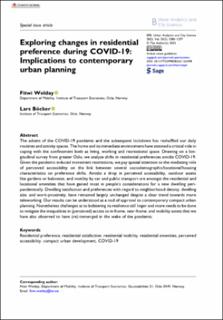| dc.contributor.author | Wolday, Fitwi | |
| dc.contributor.author | Böcker, Lars | |
| dc.coverage.spatial | Oslo, Norway | en_US |
| dc.date.accessioned | 2024-01-17T16:24:43Z | |
| dc.date.available | 2024-01-17T16:24:43Z | |
| dc.date.created | 2023-03-24T12:56:04Z | |
| dc.date.issued | 2023-03-23 | |
| dc.identifier.citation | Environment and planning. B: Urban analytics and city science. 2023, 50 (5), 1280-1297. | en_US |
| dc.identifier.issn | 2399-8083 | |
| dc.identifier.uri | https://hdl.handle.net/11250/3112305 | |
| dc.description.abstract | The advent of the COVID-19 pandemic and the subsequent lockdown has reshuffled our daily routines and activity spaces. The home and its immediate environment have attained a critical role in coping with the confinement both as living, working and recreational space. Drawing on a longitudinal survey from greater Oslo, we analyze shifts in residential preferences amidst COVID-19. Given the pandemic induced movement restrictions, we pay special attention to the mediating role of perceived accessibility on the link between several sociodemographic/locational/housing characteristics on preference shifts. Amidst a drop in perceived accessibility, outdoor assets like gardens or balconies, and motility by car and public transport are amongst the residential and locational amenities that have gained most in people’s considerations for a new dwelling peri-pandemically. Dwelling satisfaction and preferences with regard to neighborhood density, dwelling size, and work-proximity, have remained largely unchanged despite a clear trend towards more teleworking. Our results can be understood as a nod of approval to contemporary compact urban planning. Nonetheless challenges as to bolstering its resilience still linger and more needs to be done to mitigate the inequalities in (perceived) access to in-home, near-home, and mobility assets that we have also observed to have (re)-immerged in the wake of the pandemic. | en_US |
| dc.description.abstract | Exploring changes in residential preference during COVID-19: Implications to contemporary urban planning | en_US |
| dc.language.iso | eng | en_US |
| dc.publisher | Sage Journals | en_US |
| dc.rights | Navngivelse-Ikkekommersiell 4.0 Internasjonal | * |
| dc.rights.uri | http://creativecommons.org/licenses/by-nc/4.0/deed.no | * |
| dc.title | Exploring changes in residential preference during COVID-19: Implications to contemporary urban planning | en_US |
| dc.title.alternative | Exploring changes in residential preference during COVID-19: Implications to contemporary urban planning | en_US |
| dc.type | Journal article | en_US |
| dc.type | Peer reviewed | en_US |
| dc.rights.holder | © The Author(s) 2023 | en_US |
| dc.description.version | publishedVersion | en_US |
| cristin.ispublished | true | |
| cristin.fulltext | original | |
| cristin.qualitycode | 2 | |
| dc.identifier.doi | 10.1177/23998083231164398 | |
| dc.identifier.cristin | 2136682 | |
| dc.source.journal | Environment and planning. B: Urban analytics and city science | en_US |
| dc.source.volume | 50 | en_US |
| dc.source.issue | 5 | en_US |
| dc.source.pagenumber | 1280-1297 | en_US |
| dc.relation.project | Norges forskningsråd: 316126 | en_US |

